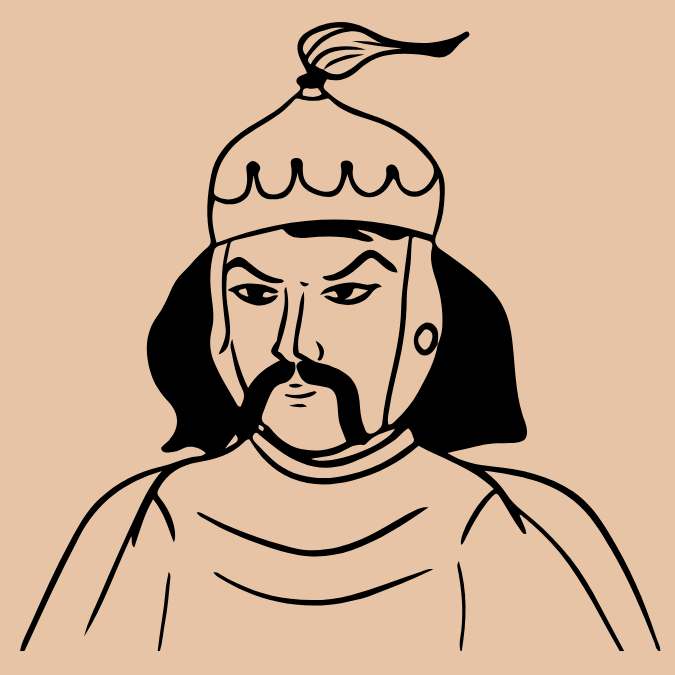
The origins of the Huns remain one of the great enigmas of ancient history. Most historians agree that they came from Central Asia, possibly from the region north of modern-day Mongolia or Kazakhstan. Some scholars link them to the Xiongnu, a confederation of nomadic tribes that had long threatened China before being driven westward.
By the 370s CE, the Huns had migrated west across the Eurasian Steppe, reaching the Volga River and then the lands north of the Black Sea. Their arrival marked a turning point in European history — and the beginning of a chain reaction that would shake the Roman world to its core.
🌪️ The Arrival in Europe: Terror on Horseback
Around 370 CE, the Huns crossed into Europe and defeated the Alans, a powerful Iranian-speaking people living north of the Black Sea. They then turned their attention to the Goths, pushing them toward the Danube River. The terrified Goths sought refuge inside the Roman Empire, which reluctantly allowed them to cross the border.
This migration, triggered by the advance of the Huns, set off a massive domino effect known as The Great Migration — a key event that contributed to the eventual fall of the Western Roman Empire.
Contemporary Roman writers, such as Ammianus Marcellinus, described the Huns as almost supernatural beings — wild, cruel, and unstoppable. He wrote that they were “little more than wild beasts, fierce and inhuman.” Of course, these accounts were influenced by fear and bias, but they reveal how deeply the Huns shocked the settled civilizations of Europe.
🏕️ The Huns’ Way of Life: Nomads of the Steppe
To understand the power of the Huns, one must understand their nomadic culture. They were horse people, born to the saddle and raised to fight. Their entire way of life revolved around mobility, speed, and survival in the vast, harsh landscapes of the Eurasian Steppe.
⚔️ Skills and Daily Life
- Horsemanship: From a young age, Huns learned to ride and shoot from horseback. Their composite bows, made from wood, horn, and sinew, were among the most advanced weapons of their time.
- Housing: They lived in portable tents (yurts) made from animal skins, moving frequently in search of pasture for their herds.
- Economy: Their wealth came from raiding, trade, and tribute, rather than farming. They traded horses, furs, and slaves for Roman gold and luxury goods.
- Clothing and Appearance: Contemporary sources describe them as wearing animal skins and having scarred faces, allegedly from ritual cuts made during childhood.
Though often depicted as “barbarians,” the Huns had a highly organized society based on kinship ties and loyalty to powerful chiefs.
👑 The Rise of Attila the Hun: The Scourge of God
No discussion of the Huns is complete without Attila, their most famous and feared ruler. Known as “The Scourge of God”, Attila ruled from 434 to 453 CE, and under his leadership, the Huns reached the peak of their power.
⚔️ The Early Years
Attila came to power with his brother Bleda after the death of their uncle Rugila. Together, they strengthened relations with the Roman Empire, forcing the Eastern Roman Emperor Theodosius II to pay vast sums of gold as tribute. When Bleda died — possibly murdered by Attila — Attila became sole ruler and began his campaign of terror across Europe.
💰 The Diplomacy of Fear
Attila was not only a warrior but also a master diplomat and strategist. He understood the political weakness of the Roman Empire and used both violence and negotiation to his advantage.
He demanded tribute payments from the Eastern Roman Empire and punished any betrayal with devastating invasions. His ability to combine diplomacy with ruthless warfare made him nearly unbeatable.
🔥 The Great Campaigns of Attila
Attila’s military campaigns were legendary, shaking both halves of the Roman Empire.
⚔️ The Eastern Campaigns (441–447 CE)
Attila first attacked the Eastern Roman Empire, invading the Balkans and destroying cities such as Naissus (modern Niš) and Serdica (Sofia). The devastation was so immense that Emperor Theodosius II was forced to sign the Treaty of Margus, agreeing to pay enormous tributes of gold to keep the Huns away.
But peace was short-lived. In 447, Attila invaded again, reaching the gates of Constantinople. Although the city’s mighty walls saved it from destruction, much of the Balkans lay in ruins.
🛡️ The Western Campaigns (451–453 CE)
In 451 CE, Attila turned his attention westward, invading Gaul (modern France). There, he met his first real defeat at the Battle of the Catalaunian Plains (or Chalons), where a coalition of Roman and Visigothic forces led by General Flavius Aetius halted the Hunnic advance.
Despite the setback, Attila was not finished. In 452 CE, he invaded Italy, devastating cities like Aquileia and forcing panic in Rome itself. According to legend, Pope Leo I personally met Attila and persuaded him to withdraw — though the reasons for his retreat remain debated (possibly disease, famine, or logistical exhaustion).
💀 The Death of Attila and the Fall of the Huns
In 453 CE, Attila died suddenly on his wedding night. Historical accounts suggest he suffered a massive nosebleed or internal hemorrhage, though some speculate that he was murdered. His death marked the beginning of the end for the Hunnic Empire.
Without Attila’s strong leadership, the confederation quickly disintegrated. His sons fought among themselves, and by 469 CE, the Huns had been defeated by a coalition of Germanic tribes at the Battle of Nedao.
The once-mighty empire of horsemen vanished as swiftly as it had appeared.
🌍 Legacy of the Huns: Fear, Change, and Transformation
Although the Huns’ empire was short-lived, their impact on world history was profound.
⚖️ 1. The Fall of the Western Roman Empire
By pushing the Goths and other tribes into Roman territory, the Huns set in motion the Great Migration Period (Migrationes Barbarorum) — a massive demographic shift that eventually led to the collapse of the Western Roman Empire in 476 CE.
In this sense, the Huns acted as a catalyst for transformation, accelerating the end of the ancient world and the birth of medieval Europe.
⚔️ 2. The Model of Steppe Empires
The Huns’ success as a mobile, militarized confederation influenced later nomadic powers such as the Avars, Magyars, and Mongols. Their combination of speed, psychological warfare, and adaptability became the blueprint for future steppe empires.
🧩 3. The Myth and the Memory
For centuries, the name “Hun” became synonymous with barbarism and destruction. Medieval chroniclers and later European cultures used “Hun” as a term for savagery — even resurfacing in modern times during World War I, when Allied propaganda referred to German soldiers as “Huns.”
However, modern historians have begun to challenge this view, emphasizing the Huns’ sophistication, organization, and diplomatic skill. While undeniably brutal in warfare, they were also skilled negotiators, traders, and empire-builders.
🕯️ The Mystery of the Huns: What Happened After?
After their defeat, many Huns were absorbed into other steppe cultures or Germanic kingdoms. Some settled in the Carpathian Basin, influencing the peoples who would later form the Hungarian nation (though the Hungarians themselves are not direct descendants of the Huns).
The disappearance of the Huns remains one of the great puzzles of early medieval history — a dramatic rise and fall that left behind legends rather than written records.
🧭 Conclusion: The Huns — Riders of Destiny
Between 370 and 469 CE, the Huns swept across Europe like a storm, terrifying empires, toppling kingdoms, and rewriting history. Led by the fearsome Attila, they embodied both the power and fragility of nomadic civilization.
Their empire may have lasted only a century, but their influence endured for millennia — in myth, language, and the shifting political landscape of Europe.
The story of the Huns is not merely one of violence and destruction. It is also a story of adaptation, leadership, and the unstoppable force of change. Like the wind that carried them across the steppes, the Huns reshaped the ancient world — and their shadow still lingers in the chronicles of human history. 🏹
Sources:
- Ammianus Marcellinus, Res Gestae
- Priscus of Panium, Fragments on Attila
- Peter Heather, The Fall of the Roman Empire (Oxford University Press, 2005)
- E.A. Thompson, The Huns (Blackwell, 1996)
- Christopher Kelly, Attila the Hun: Barbarian Terror and the Fall of the Roman Empire (Random House, 2008)
- Oxford Classical Dictionary (2022 Edition)
- Encyclopaedia Britannica (2024)

